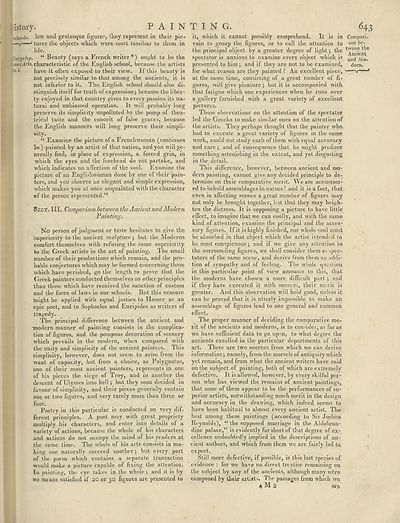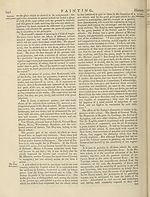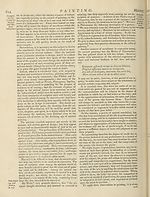Encyclopaedia Britannica > Volume 15, NIC-PAR
(719) Page 643
Download files
Complete book:
Individual page:
Thumbnail gallery: Grid view | List view

istory. - PAIN
Schools, low ami grotesque figuresj they represent in their pic-
tures the obiects which wrere most iamilmr to them in
life.
Zncyclop. “ Beauty (says a French writer*) ought to be the
ymxArts, characteristic of the English school, because the artists
iu.i. lliiVe it often exposed to their view. If this beauty is
not precisely similar to that among the ancients, it is
not inferior to it. The English school should also di¬
stinguish itself for truth of expression; because the liber¬
ty enjoyed in that country gives to every passion its na¬
tural and unbiassed operation. It will probably long
preserve its simplicity unpolluted by the pomp of thea¬
trical taste and the conceit of false graces, because
the English manners will long preserve their simpli¬
city.
“ Examine the picture of a Frenchwoman (continues
he) painted by an artist of that nation, and you will ge¬
nerally find, in place of expression, a forced grin, in
which the eyes and the forehead do not partake, and
which indicates no affection of the soul. Examine the
picture of an Englishwoman done by one of their pain¬
ters, and you observe an elegant and simple expression,
which makes you at once acquainted with the character
ef the person represented.”
Sect. III. Comparison between the Ancient and Modern
Painting.
No person of judgment or taste hesitates to give the
superiority to the ancient sculpture j but the Moderns
comfort themselves with refusing the same superiority
to the Greek artists in the art of painting. The small
number of their productions which remain, and the pro¬
bable conjectures which may be formed concerning those
which have perished, go the length to prove that the
Greek painters conducted themselves on other principles
than those which have received the sanction of custom
and the force of laws in our schools. But this censure
might be applied with equal justice to Homer as an
epic poet, and to Sophocles and Euripides as writers of
tragedy.
The principal difference between the ancient and
•modern manner of painting consists in the complica¬
tion of figures, and the pompous decoration of scenery
which prevails in the modern, when compared with
the unity and simplicity of the ancient painters. This
simplicity, however, does not seem to arise from the
want of capacity, but from a choice, as Polygnotus,
one of their most ancient painters, represents in one
of his pieces the siege ef Troy, and in another the
descent of Ulysses into hell; but they soon decided in
favour of simplicity, and their pieces generally contain
one or two figures, and very rarely more than three or
four.
Poetry in this particular is conducted on very dif¬
ferent principles. A poet may with great propriety
multiply his characters, and enter into details of a
variety of actions, because the whole of his characters
and actions do not occupy the mind of his readers at
the same time. The whole of his arts consists in ma¬
king one naturally succeed another; but every part
of the poem which contains a separate transaction
would make a picture capable of fixing the attention.
In painting, the eye takes in the whole ; and it is by
»3 means satisfied if 20 or 30 figures are presented to
TING. 643
it, which it cannot possibly comprehend. It is in Compavi-
vain to group the figures, or to call the attention to lje~
the principal object by a greater degree of light; the ^^ient6
spectator is anxious to examine every object which is all(j Ai(K
presented to him ; and if they are not to be examined, dern.
for what reason are they painted ? An excellent piece, "-v
at the same time, consisting of a great number of fi¬
gures, will give pleasure ; but it is accompanied with
that fatigue which one experiences when he runs over
a gallex-y furnished with a great variety of excellent
pictures.
Those observations on the attention of the spectator
led the Greeks to make similar ones on the attention of
the artists. They perhaps thought that the painter who
had to execute a great variety of figures in the same
work, could not study each of them with equal accuracy
and care; and of consequence that he might produce
something astonishing in the extent, and yet disgusting
in the detail.
This difference, however, between ancient and mo¬
dern painting, cannot give any decided principle to de¬
termine on their comparative merit. We are accustom¬
ed to behold assemblages in nature! and it is a fact, that
even in affecting scenes a great number of figures may
not only be brought together, bat that they may heigh¬
ten the distress. It is supposing a picture to have little
effect, to imagine that we can coolly, and with the same
kind of attention, examine the principal and the acces¬
sory figures. If it is highly finished, our whole soul must
be absorbed in that object which the artist intended to
be most conspicuous ; and if we give any attention to
the surrounding figures, we shall consider them as spec¬
tators of the same scene, and derive from them an addi¬
tion of sympathy and of feeling. The whole question
in this particular point of view amounts to this, that
the moderns have chosen a more difficult part ; and
if they have executed it with success, their merit is
greater. And this observation will hold good, unless it
can be proved that it is utterly impossible to make an
assemblage of figures lead to one general and common
effect.
The proper manner of deciding the comparative me¬
rit of the ancients and moderns, is to consider, as far as
we have sufficient data to go upon, to what degree the
ancients excelled iu the particular departments of this
art. There are two sources from which we can derive
information; namely, from the morsels of antiquity wdiich
yet remain, and from what the ancient writers have said
on the subject of painting, both of which are extremely
defective. It is allowed, however, by every skilful per¬
son who has viewed the remains of ancient paintings,
that none of them appear to be the performances of su¬
perior artists, notwithstanding much merit in the design
and accuracy in the drawing, which indeed seems to
have been habitual to almost every ancient artist. The
best among these paintings (according to Sir Joshua
Reynolds), “ the supposed marriage in the Aldobran-
dine palace,” is evidently far short of that degree of ex¬
cellence undoubtedly implied in the descriptions of an¬
cient authors, and which from them we are fairly led to
expect.
Still more defective, if possible, is this last species of
evidence : for we have no direct treatise remaining on
the subject by any of the ancients, although many were
composed by their artists. The passages from which we
4 M 2 are
Schools, low ami grotesque figuresj they represent in their pic-
tures the obiects which wrere most iamilmr to them in
life.
Zncyclop. “ Beauty (says a French writer*) ought to be the
ymxArts, characteristic of the English school, because the artists
iu.i. lliiVe it often exposed to their view. If this beauty is
not precisely similar to that among the ancients, it is
not inferior to it. The English school should also di¬
stinguish itself for truth of expression; because the liber¬
ty enjoyed in that country gives to every passion its na¬
tural and unbiassed operation. It will probably long
preserve its simplicity unpolluted by the pomp of thea¬
trical taste and the conceit of false graces, because
the English manners will long preserve their simpli¬
city.
“ Examine the picture of a Frenchwoman (continues
he) painted by an artist of that nation, and you will ge¬
nerally find, in place of expression, a forced grin, in
which the eyes and the forehead do not partake, and
which indicates no affection of the soul. Examine the
picture of an Englishwoman done by one of their pain¬
ters, and you observe an elegant and simple expression,
which makes you at once acquainted with the character
ef the person represented.”
Sect. III. Comparison between the Ancient and Modern
Painting.
No person of judgment or taste hesitates to give the
superiority to the ancient sculpture j but the Moderns
comfort themselves with refusing the same superiority
to the Greek artists in the art of painting. The small
number of their productions which remain, and the pro¬
bable conjectures which may be formed concerning those
which have perished, go the length to prove that the
Greek painters conducted themselves on other principles
than those which have received the sanction of custom
and the force of laws in our schools. But this censure
might be applied with equal justice to Homer as an
epic poet, and to Sophocles and Euripides as writers of
tragedy.
The principal difference between the ancient and
•modern manner of painting consists in the complica¬
tion of figures, and the pompous decoration of scenery
which prevails in the modern, when compared with
the unity and simplicity of the ancient painters. This
simplicity, however, does not seem to arise from the
want of capacity, but from a choice, as Polygnotus,
one of their most ancient painters, represents in one
of his pieces the siege ef Troy, and in another the
descent of Ulysses into hell; but they soon decided in
favour of simplicity, and their pieces generally contain
one or two figures, and very rarely more than three or
four.
Poetry in this particular is conducted on very dif¬
ferent principles. A poet may with great propriety
multiply his characters, and enter into details of a
variety of actions, because the whole of his characters
and actions do not occupy the mind of his readers at
the same time. The whole of his arts consists in ma¬
king one naturally succeed another; but every part
of the poem which contains a separate transaction
would make a picture capable of fixing the attention.
In painting, the eye takes in the whole ; and it is by
»3 means satisfied if 20 or 30 figures are presented to
TING. 643
it, which it cannot possibly comprehend. It is in Compavi-
vain to group the figures, or to call the attention to lje~
the principal object by a greater degree of light; the ^^ient6
spectator is anxious to examine every object which is all(j Ai(K
presented to him ; and if they are not to be examined, dern.
for what reason are they painted ? An excellent piece, "-v
at the same time, consisting of a great number of fi¬
gures, will give pleasure ; but it is accompanied with
that fatigue which one experiences when he runs over
a gallex-y furnished with a great variety of excellent
pictures.
Those observations on the attention of the spectator
led the Greeks to make similar ones on the attention of
the artists. They perhaps thought that the painter who
had to execute a great variety of figures in the same
work, could not study each of them with equal accuracy
and care; and of consequence that he might produce
something astonishing in the extent, and yet disgusting
in the detail.
This difference, however, between ancient and mo¬
dern painting, cannot give any decided principle to de¬
termine on their comparative merit. We are accustom¬
ed to behold assemblages in nature! and it is a fact, that
even in affecting scenes a great number of figures may
not only be brought together, bat that they may heigh¬
ten the distress. It is supposing a picture to have little
effect, to imagine that we can coolly, and with the same
kind of attention, examine the principal and the acces¬
sory figures. If it is highly finished, our whole soul must
be absorbed in that object which the artist intended to
be most conspicuous ; and if we give any attention to
the surrounding figures, we shall consider them as spec¬
tators of the same scene, and derive from them an addi¬
tion of sympathy and of feeling. The whole question
in this particular point of view amounts to this, that
the moderns have chosen a more difficult part ; and
if they have executed it with success, their merit is
greater. And this observation will hold good, unless it
can be proved that it is utterly impossible to make an
assemblage of figures lead to one general and common
effect.
The proper manner of deciding the comparative me¬
rit of the ancients and moderns, is to consider, as far as
we have sufficient data to go upon, to what degree the
ancients excelled iu the particular departments of this
art. There are two sources from which we can derive
information; namely, from the morsels of antiquity wdiich
yet remain, and from what the ancient writers have said
on the subject of painting, both of which are extremely
defective. It is allowed, however, by every skilful per¬
son who has viewed the remains of ancient paintings,
that none of them appear to be the performances of su¬
perior artists, notwithstanding much merit in the design
and accuracy in the drawing, which indeed seems to
have been habitual to almost every ancient artist. The
best among these paintings (according to Sir Joshua
Reynolds), “ the supposed marriage in the Aldobran-
dine palace,” is evidently far short of that degree of ex¬
cellence undoubtedly implied in the descriptions of an¬
cient authors, and which from them we are fairly led to
expect.
Still more defective, if possible, is this last species of
evidence : for we have no direct treatise remaining on
the subject by any of the ancients, although many were
composed by their artists. The passages from which we
4 M 2 are
Set display mode to:
![]() Universal Viewer |
Universal Viewer | ![]() Mirador |
Large image | Transcription
Mirador |
Large image | Transcription
Images and transcriptions on this page, including medium image downloads, may be used under the Creative Commons Attribution 4.0 International Licence unless otherwise stated. ![]()
| Encyclopaedia Britannica > Encyclopaedia Britannica > Volume 15, NIC-PAR > (719) Page 643 |
|---|
| Permanent URL | https://digital.nls.uk/192591045 |
|---|
| Attribution and copyright: |
|
|---|
| Shelfmark | EB.11 |
|---|---|
| Description | Ten editions of 'Encyclopaedia Britannica', issued from 1768-1903, in 231 volumes. Originally issued in 100 weekly parts (3 volumes) between 1768 and 1771 by publishers: Colin Macfarquhar and Andrew Bell (Edinburgh); editor: William Smellie: engraver: Andrew Bell. Expanded editions in the 19th century featured more volumes and contributions from leading experts in their fields. Managed and published in Edinburgh up to the 9th edition (25 volumes, from 1875-1889); the 10th edition (1902-1903) re-issued the 9th edition, with 11 supplementary volumes. |
|---|---|
| Additional NLS resources: |
|

